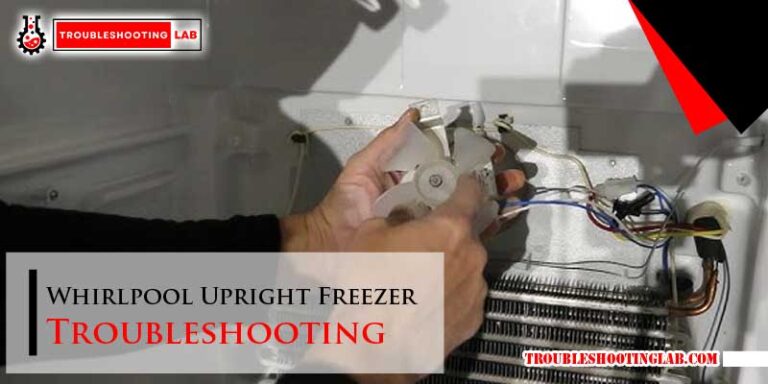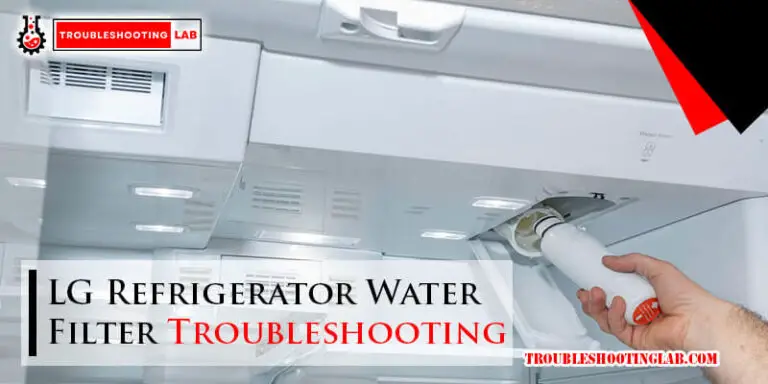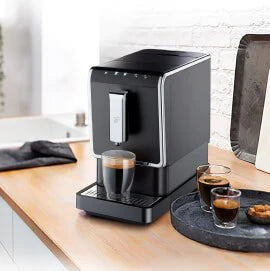Kitchenaid Ice Maker Troubleshooting: Fixing Common Issues
To troubleshoot a Kitchenaid ice maker, make sure the water supply is properly connected and the water shut-off valve is fully opened. Check for any kinks in the water supply line and straighten it if necessary.
If the ice maker is still not making ice, you can try defrosting the water line with a hair dryer or letting the refrigerator sit unplugged for a couple of hours. Restore power and listen for the water supply to fill the ice mold.
If these steps do not resolve the issue, it is recommended to consult with a professional for further assistance.

Common Issues With Kitchenaid Ice Maker
Having trouble with your Kitchenaid ice maker? Common issues include a red light, no water, and it not cooling properly. Check the water supply, ensure there are no kinks in the water line, and try resetting the ice maker. For more troubleshooting tips, visit the Kitchenaid website.
Ice Maker Not Making Ice
If your Kitchenaid ice maker is not making ice, there could be a few reasons for this issue. First, check if the water supply is properly connected to a cold water supply and make sure the water shutoff valve is fully opened. Additionally, examine the water supply line for any kinks that can reduce water flow. Straightening the water source line can restore adequate water flow and pressure. If these steps do not solve the problem, try resetting the ice maker by referring to the product manual or watching the troubleshooting video provided by Kitchenaid.
Red Light
A red light on your Kitchenaid ice maker can indicate an issue with the machine. This could be caused by a variety of reasons, such as a full bin, a clogged water filter, or a malfunctioning sensor. Start by checking the ice bin to see if it is full. If it is, empty the ice and allow the machine to resume making ice. Next, inspect the water filter and replace it if necessary. If the problem persists, it may be advisable to call a professional appliance repair service to diagnose and fix the issue.
No Water
If your Kitchenaid ice maker is not receiving water, there are a few potential causes. First, make sure that the water supply line is properly connected and the water shutoff valve is fully opened. Check for any kinks or bends in the water supply line that could be obstructing water flow. Straighten the line if necessary. If the problem persists, it could be due to a malfunctioning water inlet valve or a clogged water filter. In such cases, it is recommended to consult a professional technician for assistance.
Not Cooling
If your Kitchenaid ice maker is not cooling, it is important to address the issue promptly to prevent any further damage. First, check that the appliance is plugged in and receiving power. Ensure that the temperature settings are correctly adjusted and set to the recommended level. If the compressor is running but the ice maker is still not cooling, there may be a problem with the condenser coils or the evaporator fan motor. In such cases, it is best to consult a professional appliance repair service for further troubleshooting and repairs.
Troubleshooting Steps
Having trouble with your Kitchenaid ice maker? Follow these troubleshooting steps to resolve common issues such as a red light, no water, or not cooling. Check the water supply, ensure there are no kinks in the water line, and straighten it if necessary.
If the problem persists, consider consulting a professional for further assistance.
When it comes to troubleshooting your Kitchenaid ice maker, there are a few key steps you can take to identify and fix the issue. By following these troubleshooting steps, you can get your ice maker back up and running in no time.
Check Water Supply
The first step in troubleshooting your Kitchenaid ice maker is to check the water supply. Ensure that the water supply is properly connected to a cold water supply and that the water shutoff valve is fully opened. Oftentimes, a lack of water supply can be the culprit for your ice maker not producing ice. If you discover any issues with the water supply, address them first before moving on to the next troubleshooting step.
Inspect Water Supply Line
The next step in troubleshooting your Kitchenaid ice maker is to inspect the water supply line. Check for any kinks or obstructions in the supply line that may be restricting water flow. Straighten out any kinks or remove any obstructions to restore adequate water flow and pressure. This simple step can often solve the problem and get your ice maker working again.
Reset The Ice Maker
If checking the water supply and inspecting the supply line didn’t resolve the issue, the next troubleshooting step is to reset the ice maker. To reset the ice maker, locate the reset button on the ice maker control panel. Press and hold the reset button for 10-15 seconds until you hear a chime or see the ice maker’s indicator light change color. This will reset the ice maker and can often fix any software or mechanical issues that may be causing the problem.
By following these troubleshooting steps, you can quickly identify and fix common issues with your Kitchenaid ice maker. Remember to check the water supply, inspect the water supply line, and reset the ice maker if necessary. With these simple steps, you can enjoy a fully functional ice maker once again.
Potential Causes
The potential causes of Kitchenaid ice maker troubleshooting include improper water supply connection, kinks in the water supply line, and clogged water lines. It is important to ensure proper water flow and pressure to fix the issue.
Water Supply Issue
If your Kitchenaid ice maker is not working properly, a potential cause could be a water supply issue. Ensure that the water supply is properly connected to a cold water supply and that the water shutoff valve is fully opened.
Check for any kinks in the water supply line, as a kink can reduce water flow. Straighten the water source line to restore adequate water flow and pressure.
Clogged Water Line
Another potential cause for your Kitchenaid ice maker troubles could be a clogged water line. If you suspect a clog, there are a few steps you can take to unclog the water line.
- First, try using a hair dryer to defrost the water line. Alternatively, you can unplug the refrigerator and let it sit for a couple of hours to defrost.
- Once the water line is defrosted, restore power to the refrigerator and listen for the water supply to fill the ice mold.
- If the clog is not translucent or you’re unsure how to remove it, it is best to consult with a professional for assistance.
Faulty Inlet Valve
A faulty inlet valve can also be a potential cause for your ice maker troubles. The inlet valve controls the water flow into the ice maker, so if it’s malfunctioning, it can disrupt the ice-making process.
If you suspect a faulty inlet valve, it is recommended to seek professional help to diagnose and replace the valve if necessary.
Additional Tips And Solutions
Looking for additional tips and solutions for troubleshooting your Kitchenaid ice maker? Make sure to check the water supply connection, straighten any kinks in the water supply line, and unclog the water line if necessary. For more information and step-by-step instructions, visit Kitchenaid’s website.
Properly Seating The Water Filter
If your Kitchenaid ice maker is not producing ice or the ice cubes are small, it might be because the water filter is not properly seated. Follow these steps to make sure the water filter is correctly installed:
- Locate the water filter compartment in your Kitchenaid ice maker.
- Turn off the ice maker and unplug it from the power source.
- Remove the water filter from the compartment. Check for any visible signs of damage or clogging.
- Clean the water filter housing and the new filter if necessary.
- Insert the new filter into the housing and push it firmly until it clicks into place.
- Plug the ice maker back into the power source and turn it on.
- Wait for the ice maker to start producing ice again.
Checking For Jammed Ice
If your Kitchenaid ice maker is running but not dispensing ice, there might be jammed ice blocking the dispenser. Follow these steps to check for jammed ice:
- Open the ice maker door and locate the ice storage bin.
- Inspect the ice cubes inside the bin for any signs of clumping or blockage.
- If you notice any jammed or clumped ice, remove it gently using a plastic utensil.
- Check the ice dispenser chute for any obstructions. Clear any debris if necessary.
- Close the ice maker door and wait for it to start dispensing ice again.
Inspecting Cooling Components
If your Kitchenaid ice maker is not cooling properly or the ice cubes are melting, it could be due to issues with the cooling components. Follow these steps to inspect the cooling components:
- Unplug the ice maker from the power source and open the freezer compartment.
- Check the condenser coils at the back of the ice maker. If they are covered in dust or debris, use a vacuum cleaner or a brush to clean them.
- Inspect the evaporator fan inside the freezer. Make sure it is running smoothly and there are no obstructions blocking its rotation.
- Check the temperature settings on your ice maker. Ensure they are set to the optimal cooling level for ice production.
- Close the freezer compartment and plug the ice maker back into the power source.
- Monitor the ice maker to see if it starts producing ice again and if the ice cubes remain frozen.
When To Seek Professional Help
If you’ve followed all the troubleshooting steps and your Kitchenaid ice maker is still not working properly, it may be time to seek professional help. Here are some instances where it’s best to call in a professional:
Persistent Issues
If your ice maker is consistently producing low-quality ice or you’re experiencing inconsistent ice production despite multiple attempts at troubleshooting, it’s best to seek the expertise of a professional. They have the knowledge and tools to diagnose the underlying issue and provide a long-lasting solution. Don’t let persistent issues with your ice maker ruin your chilling experience.
Complex Repairs
Some ice maker problems may require complex repairs that are beyond the scope of a typical DIY enthusiast. If you’re facing issues such as a malfunctioning control board, a fault in the ice maker motor, or issues with the water pump, it’s best to leave it to the professionals. Attempting complex repairs without the necessary experience can potentially cause further damage to your ice maker.
Frequently Asked Questions
How Do I Reset My Kitchenaid Ice Maker?
To reset your KitchenAid ice maker, make sure the water supply is properly connected and the shutoff valve is fully opened. Check for any kinks in the water supply line and straighten it if necessary. If the line is clogged, defrost it with a hairdryer or let the refrigerator sit unplugged for a couple of hours.
Restore power and listen for the water supply to fill the ice mold. If the issue persists, consult a professional for assistance.
Why Is My Kitchenaid Ice Machine Not Making Ice?
Make sure your KitchenAid ice machine is properly connected to a cold water supply and the shutoff valve is fully opened. Check for any kinks in the water supply line and straighten it out if necessary. If the water line is clogged, try defrosting it with a hair dryer or unplugging the refrigerator.
If the problem persists, consult a professional.
Why Is My Ice Maker Not Making Ice But The Water Works?
Make sure the water supply is connected and the valve is open. Check for any kinks in the water line. Straighten it to improve water flow. To unclog, use a hair dryer or unplug the fridge for a few hours.
If the issue persists, seek professional help.
How Do I Unclog My Ice Maker Water Line?
To unclog your ice maker water line, try defrosting the line with a hair dryer or leaving the refrigerator unplugged for a few hours. Once defrosted, plug the refrigerator back in and listen for water to fill the ice mold.
If the clog persists, consult a professional for assistance.
Why Is My Kitchenaid Ice Machine Not Making Ice?
Make sure the water supply is properly connected and the water shutoff valve is fully opened. Check for kinks in the water supply line and straighten it if necessary.
Conclusion
To troubleshoot your KitchenAid ice maker, ensure that the water supply is connected properly and the shutoff valve is fully opened. Check for any kinks in the water supply line that may be reducing water flow. Straighten the line to improve water flow.
If the ice maker is still not making ice, try defrosting the water line or consult a professional for assistance with removing clogs. Don’t worry, there are solutions to get your ice maker working again!




